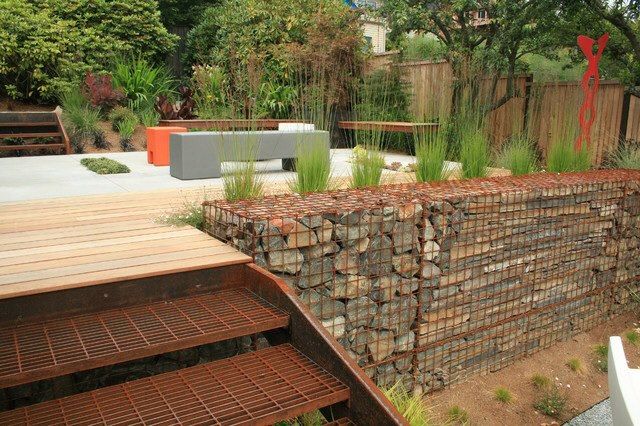How Do You Keep A Gabion Wall Straight?

Gabion walls are functional and add a unique aesthetic to landscaping and construction projects. However, ensuring your gabion wall remains straight is crucial to its structural integrity and visual appeal. This comprehensive guide will explore techniques and tips for keeping your gabion wall straight. From proper site preparation to careful construction, we'll cover everything you need to know to create a sturdy and attractive gabion wall.
Tips for keeping gabion wall straight and sturdy
1.Site Preparation:
Before you start constructing your gabion wall, thorough site preparation is essential. The foundation and the terrain upon which the wall will be built play a significant role in its stability. Here are the key steps to ensure proper site preparation:
Clear the Area:
Remove any vegetation, debris, or obstructions from the construction site. This includes rocks, roots, and organic matter that could affect the wall's stability.
Level Ground:
Ensure that the ground is level and compacted. Use a surveyor's or laser level to check for any unevenness, as even a slight slope can impact the wall's alignment.
Proper Drainage:
Address drainage issues to prevent water from accumulating behind the gabion wall. Adequate drainage is crucial for controlling erosion and maintaining the wall's stability over time.
2. Foundation
A solid foundation is the backbone of a straight gabion wall. It provides the necessary support to prevent leaning or tilting. Here's how to establish a sturdy foundation:
Excavation:
Dig a trench along the wall's length and width. The depth of the trench will depend on the wall's height and the recommendations of your project engineer. Typically, a depth of 1 to 2 feet is suitable.
Compaction:
Compact the soil at the bottom of the trench thoroughly. You can use a plate compactor or a hand tamper to achieve the desired level of compaction.
Geotextile Fabric:
Place a layer of geotextile fabric at the bottom of the trench. This fabric will act as a barrier to prevent soil from washing out between the gabion baskets and aid in drainage.
3. Choosing the Right Gabion Baskets
Selecting the appropriate gabion baskets is crucial for a straight and stable wall. Consider the following factors:
Size and Strength:
Choose gabion baskets to withstand the expected loads and environmental conditions. Heavier-duty baskets may be required for taller or broader walls.
Mesh Size:
The mesh openings should be appropriate for the size of the stones you plan to use as fill. Smaller rocks may require smaller mesh openings to prevent them from falling out.
Material:
Opt for high-quality galvanized or stainless steel gabion baskets to ensure they resist corrosion and remain durable over time.
4 Filling the Gabion Baskets
The filling process is a critical step in keeping your gabion wall straight. Correctly filled baskets provide the necessary weight and stability. Here's how to do it:
Select Suitable Stones:
Choose stones that are uniform in size and shape. Rounded river stones or angular quarry rocks work well. Avoid using irregularly shaped stones that can create voids and weaken the wall.
Layering:
Fill the gabion baskets in even layers, starting from the bottom. Compact each layer with a tamper or by hand to ensure a tight fit. Avoid overfilling, as this can cause bulging and instability.
Interlock Stones:
Place larger stones on the outer layer to interlock and create a visually appealing face. Fill the inner layers with smaller rocks to maximize stability.
5. Proper Basket Connection:
To maintain the straight alignment of your gabion wall, ensure that the baskets are securely connected. Here's how to do it:
Overlap Baskets:
Overlap the edges of adjacent gabion baskets by at least 3 to 6 inches to create a strong connection. Use wire or spiral connectors to secure the overlap.
Secure the Tops:
To prevent sagging or leaning, use bracing wires or rods at the top of the wall. These should be anchored to a stable structure or embedded deep into the ground.
6. Regular Maintenance
Once your gabion wall is constructed, it's essential to perform regular maintenance to ensure it remains straight and stable over time.
Inspect for damage:
Periodically inspect the wall for any signs of damage, such as bulging, leaning, or erosion.
Repair as Needed:
If you notice any issues, address them promptly by repairing damaged areas and reinforcing weak spots.
Monitor Drainage:
Monitor the wall's drainage system to ensure water flows away from it effectively.
Conclusion:
A straight and sturdy gabion wall serves its functional purpose and enhances the overall aesthetics of your landscape or construction project. Following these guidelines for proper site preparation, foundation construction, basket selection, filling techniques, basket connection, and regular maintenance, you can create a gabion wall that stands the test of time while adding a touch of elegance to your surroundings.
